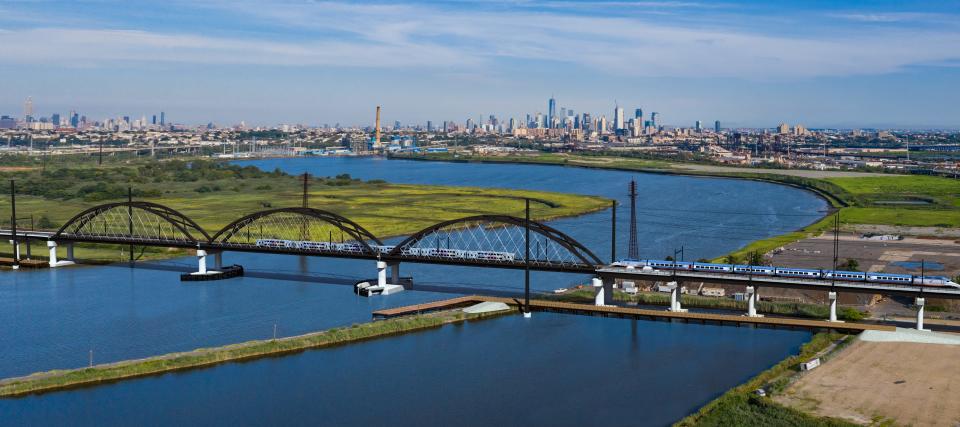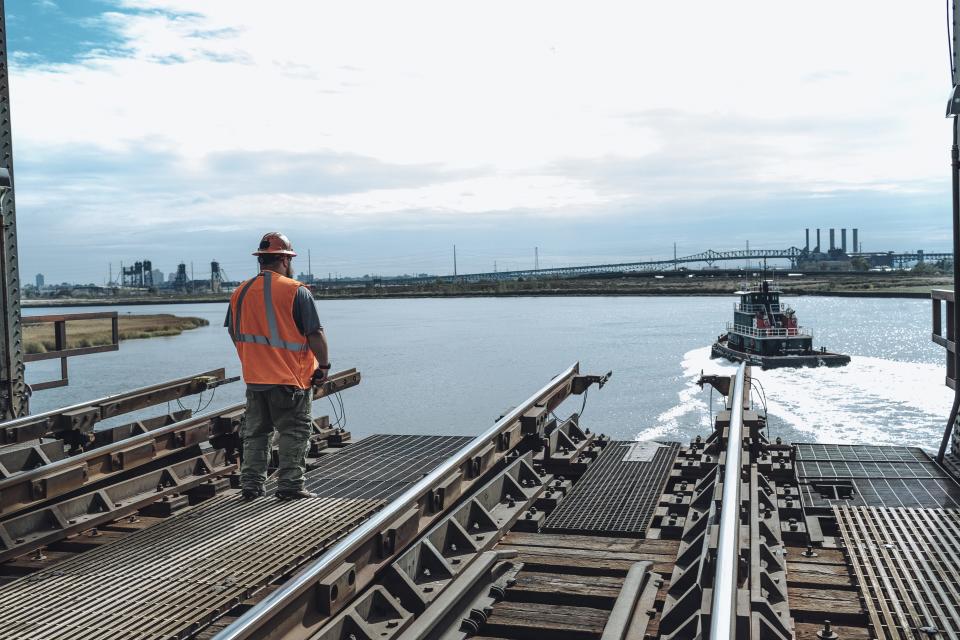Portal Bridge rail replacement project is 50% done, on time and on budget, despite hurdles
- Oops!Something went wrong.Please try again later.
KEARNY — Getting to the 50% completion mark on the new $2.3 billion Portal North Bridge — and getting there on time and on budget — required overcoming myriad challenges and, for some, debating who has accrued the most gray hairs.
“Tony, I have the most gray hair, you’re getting a few, and I hate to tell you, Kris, in another five, six years we’ll do a before-and-after picture, but thanks so much for stepping up,” joked Kevin Corbett, CEO and president of NJ Transit, the agency leading construction of the new rail bridge that spans the Hackensack River between Kearny and Secaucus.
It will be a taller, fixed-span replacement for the 114-year-old swing span that has been prone to getting stuck in recent years, causing major delays to NJ Transit and Amtrak trains headed in and out of Manhattan.
Story continues after photo gallery.
Corbett's gray hair quip Monday was directed at Tony Coscia, chairman of Amtrak’s board, and Kris Kolluri, CEO and president of the Gateway Development Commission.
The three are among the officials who have spent years, in some cases more than a decade, trying to improve the most critical chokepoint of the Northeast Corridor, which includes replacing the Portal Bridge and repairing the equally old Hudson River rail tunnel, as well as constructing a new two-track tube.
Aging infrastructure, growing delays
The gray hairs that went mostly unmentioned Monday were those of the commuters who must deal with more unpredictable delays and other frustrations of commuting on the busiest stretch of rail in the country — one that has not received the proper investment in recent decades to prevent delays and outages.
In 2023, NJ Transit canceled 870 trains because of Amtrak-related issues, due to signal problems and the Portal Bridge getting stuck or, during a particularly bad stretch last summer, because aging infrastructure and wires failed, causing major electrical outages. This was worse than 2017, when multiple derailments around New York Penn Station forced Amtrak to undergo weeks of emergency repair work, known as the infamous “Summer of Hell.”

“Amtrak does continue to — and it does it out of necessity — invest in upgrading and trying to maintain the systems that we know are going to be replaced, and that includes the Portal Bridge,” Coscia said.
“People have kicked the can down the road for way too long, so the real explanation for why we’re in this situation is the unwillingness in decades past for people to face up to the responsibility to make these investments — and now that we’re making them, we can’t ignore the operating needs on a daily basis,” he said.
Bureaucratic malaise, poor relationships between the involved agencies and questions about who is paying for what are among the many reasons a bridge that has more than 400 trains cross it on a daily basis had to wait well past its 100th birthday before construction began to replace it.
“I’m one of the people who can remember when we started conversations about replacing Portal Bridge and all the headwinds that we faced, and all the people who said you’re not going to be able to get that done, it’s too complicated, it’s too much money,” Coscia said, noting that a lot has changed since then.
“We are transforming the way train travel happens in the U.S., we are creating a level of mobility for New York City rail that has not existed for decades in this country, and that is because of the leadership that has been willing to make that kind of investment,” he said.
Much of the credit for the historic levels of investment in transit and rail goes to the Infrastructure and Investment Jobs Act, the hallmark $1.2 trillion funding package of President Joe Biden’s administration. But the kick-start to the first phase of the $18 billion Gateway program was the Portal Bridge replacement project, which received a green light under the Trump administration after New Jersey Gov. Phil Murphy ponied up $600 million in state funding to get the grant application over the finish line.

“When I think of six-plus years ago when I arrived with NJ Transit in full crisis mode, facing a world of immediate problems, I think we were at war with Amtrak before that, a world of pain, but in talking with Governor Murphy … he particularly wanted to get Gateway moving again, and particularly where we were could help out and get that moving again, and that was starting with Portal North Bridge,” Corbett said.
It was because of improved relationships and partnerships between the agencies and assistance from legislative leaders in Washington that they were able to accomplish that and the success of the project so far, Corbett added.
“We are truly in a Goldilocks zone — we will never have an opportunity like this ever again where the federal resources and the state resources have come together and advanced critical projects that have languished for 20, 30 years,” said Kolluri, who was New Jersey’s transportation commissioner in 2010 when then-Gov. Chris Christie canceled the original program to construct new rail tunnels, which would have been completed by now. “The fact that we’re here celebrating this milestone that kicks off many projects to come is something we should grab a hold of and should capitalize on.”
Corbett said he thinks the project could get done under budget before its intended completion in 2026. Though the project so far is on track, Amtrak has had to dip into the contingency portion of its contribution to address higher labor costs that arose from an exponential increase in the need for track outages because of the project, according to a recent audit report released by Amtrak’s Office of the Inspector General.
NJ Transit’s former construction manager also sued the agency, alleging in a whistleblower lawsuit that there was an increased need for outages because of ground settlement issues that he raised red flags about but says were ignored.
“Every mega project has different challenges, and we have the team, we’ve gotten this far, I have no doubt the collective team … will deliver this,” Corbett said.
This article originally appeared on NorthJersey.com: Portal Bridge project is 50% finished, on time and on budget

